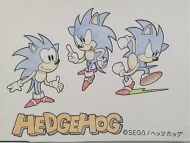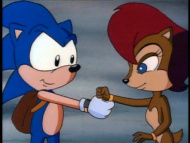Sonic the Hedgehog
From Sonic Retro
- For the video games, see Sonic the Hedgehog (8-bit), Sonic the Hedgehog (16-bit), or Sonic the Hedgehog (2006 game). For other eponymous media see Sonic the Hedgehog (disambiguation).
Sonic the Hedgehog (Japanese: (Japanese: ソニック・ザ・ヘッジホッグ), Romaji: Sonikku za hejjihoggu), "The Most Famous Hedgehog In The World," is the flagship character for home and arcade game (and former game console) maker Sega. Designed to compete with Nintendo's mascot Mario, the two companies went head to head for over a decade, until Sega pulled out of the home console market.
Sega has made numerous video games starring Sonic since his debut in 1991, spanning five generations of console manufacturing. Through numerous aggressive ad campaigns (the most famous being the touting of "Blast Processing," described as being able to render sprites at extreme speeds but actually referring to the CPU's clock rate), Sonic soon became one of the most recognizable fictional characters in the world, even beating out Mickey Mouse for a time. While his glory days may be behind him, Sonic is still a significant part of gaming, and it cannot be denied that he forever changed the gaming landscape.
Contents
Character Conception
By 1990, Sega had grown tired of playing second-fiddle to Nintendo, and sought to redefine their image with a game that would be able to go head to head with the Super Mario Bros. series. Up to this point, Sega had been using Alex Kidd as their unofficial mascot for their Master System outings, but the corporate heads wanted to present something that could directly compete with the Mario character, and in the process knock Nintendo from the number one spot in the gaming world. An internal competition was held to find a new mascot that would both appeal to a wide audience and showcase what their latest system, the Mega Drive, was capable of. While many designs were introduced ranging from a Felix-inspired Rabbit to an American-looking bulldog, and even early designs of what would end up being Dr. Eggman and Mighty the Armadillo, it was Naoto Ohshima's simple hedgehog design that caught everyone's attention.
Originally named "Mr. Needlemouse," the design of the small, blue, spiny being took many cues from American culture. The look of Sonic's classic buckled shoes took direct inspiration from Michael Jackson's boots from the cover of his "Bad" album, while the color scheme was taken from the most famous character of all time - Santa Claus. Sonic's personality, on the other hand, was directly inspired by future-President Bill Clinton, who Ohshima felt embodied a modern sensibility of wanting to get things done right away, righting wrongs as they presented themselves instead of letting them linger.[1]
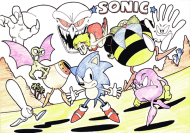
With character in hand, and the future of Sega riding on them, Sega's AM8 division (who decided to call themselves "Sonic Team") set about making what they would hope become a successful game. While Ohshima was responsible for the look of Sonic the Hedgehog, he was only one part of the team that helped bring him to life. It was Yuji Naka that helped instill Sonic's trademark sense of speed by programming what was, at the time, the fastest game anyone had played on a home console. Having been obsessed with speed as a youth, he relished creating a game engine designed around a character who was focused on the same theme, even going as far as removing the original throwing-element of gameplay because it slowed down the overall flow. Rounding off the classic trio was Hirokazu Yasuhara, the Game Planner and Director, making sure all the pieces of the game fit together, while at the same time creating fun and memorable levels that would make people want more. The work of these three men, along with the other 12 members of the team, helped propel Sonic the Hedgehog to heights not even Sega could have foreseen.
The success of Sonic the Hedgehog caused other companies to take notice, and the trend of anthropomorphic mascots was born. Sparkster, Bubsy, Crash Bandicoot, Spyro, Blinx, and Sly Cooper are only a few of the characters that have tried to emulate Sonic the Hedgehog over the years. While some were more successful than others, none could reach the heights Sonic skyrocketed to.
Sonic the Hedgehog (Video Game Character)
Origin of Sonic
File:Classic sonic orthographic.svg In the original game continuity, Sonic's past is never explicitly explained, and perhaps purposefully never hinted at. According to the Sonic the Hedgehog Technical Documents, Sonic was born on Christmas Island, although the island has yet to make an appearance within the games. The only other piece of information on Sonic's past is that he and Dr. Eggman have had a fierce rivalry that has existed long before the original Sonic the Hedgehog console game. Though the details of these early encounters are never expanded upon, it is made clear the first time the Chaos Emeralds become a source of contention is during the events of the first game. The first battle over the Chaos Emeralds was retold in the Sonic the Hedgehog Story Comic released in Japan, where Dr. Eggman first fights Sonic over the gems by interrupting a concert the hedgehog is singing in.[2] However, as the comic is based heavily on the early concepts of the game that ultimately never made it in, it is unknown how this relates to the current game continuity. Nevertheless, the ending to both is the same, with Sonic triumphing over the doctor.
While Sonic has visited and explored South Island many times, Sonic is something of a nomad, never content with staying in one place for too long. Preferring to travel to new areas and locals looking for exciting new adventures, he only slows down when Dr. Eggman appears, foiling whatever new scheme to take over the world the doctor has.
The same documents which mentioned Christmas Island (which were printed in the Sonic Adventure 2 Birthday Pack) offer an alternate, whimsical story in which Sonic the Hedgehog was originally a fictional character created by Mary Garnet, who used him in a series of children's novels. Inspired by her husband and his dream of being the first man to break the sound barrier, the character adorned the back of his jacket at the airfield he worked, becoming a mascot to those who worked alongside him. After an attempt to succeed in this dream turned tragic, both the man and and the hedgehog were slowly forgotten of as time moved on. Decades pass, and a young camerawoman attends an airshow at the same field, wearing the hedgehog-adorned jacket she recently bought at a flea market, remembering the character from her childhood. Getting caught up in an accident that occurs, she finds herself saved by a mysterious force, who she later finds was Sonic the Hedgehog, a blue blur and familiar shoes being found in her developed pictures. However, this story has never been referenced in the games, and only acknowledged by the creators of Sonic the Hedgehog as an alternate fictional story, solely intended to grab people's attention to the Mega Drive original.
Personality
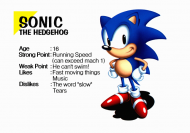
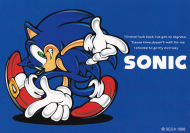
Sonic the Hedgehog is a 15 year old blue hedgehog who lives in no particular locale on the planet Earth, instead choosing to travel the world looking for fun and adventure wherever he goes. While he may be a drifter, that doesn't mean he only cares about himself. Over the course of the games, Sonic meets other people whom he becomes close with, such as the over-eager sidekick Miles "Tails" Prower, the friendly rival Knuckles the Echidna, and the obsessive fangirl Amy Rose. While some games show Sonic as more of an a-typical hero than others, traditionally he is someone who plays by his own rules, while maintaining a strong sense of justice. Even though he looks out for the underdog, he does not dedicate his life to romanticized ideals, oftentimes fighting Dr. Eggman for the fun and adventure of it all. While he doesn't let others dictate his actions, he won't hesitate if his friends are in trouble, and though he maintains a calm and cool attitude, he knows when to get serious when the stakes are high.
Sonic is known for his 'attitude', which is shown through his smugness and sarcasm. Sonic sometimes likes to show off in order to 'look cool'. He is often shown posing or adjusting his gloves or shoes. He is also often noted to be impatient and sometimes have a hot temper.
Abilities
If there is one characteristic that defines Sonic the Hedgehog, it would have to be his supersonic speed. Able to go Mach 1 on his own power, it is this that sets him apart from the other characters in the series. While many of the main players have speeds that nearly match Sonic's, it isn't unusual to see him waiting for everyone else to show up, tapping his foot and crossing his arms in impatience. Sonic also has the ability to curl up into a ball and perform a spin attack, which makes his quills a deadly enough weapon to cut through the doctor's machines and free whatever animal may lie inside. He also possesses the spin dash, in which Sonic curls into a ball, revving up enough speed where he can dash ahead without having to build up the momentum beforehand. While the spin attack and the spin dash have been emulated by many other members in the cast, they have not been able to recreate the Super Peel-Out move, in which Sonic builds up even more momentum while standing, his legs moving so fast they become a figure 8 to the naked eye. However, Sonic is not infallible, his one major weakness being that he is incapable of swimming, forced to run along the bottom of whatever water-filled zone he happens to be in, relying on any air bubbles that spring up to prevent him from drowning.
Sonic also has the capability of transforming into a super-powered version of himself through the use of whatever mystical item Sonic has to collect during his adventures, such as the Chaos Emeralds, the Super Emeralds, and the World Rings. Among his many transformations are Super Sonic, Hyper Sonic, and Darkspine Sonic. It is usually this transformation that drives the final confrontation in each installment of the Sonic the Hedgehog series.
While Sonic can still drown in his Super Sonic transformation, he cannot while being Hyper Sonic.
Sonic in Other Media
Due to the fractured nature of bringing Sonic into other mediums, Sonic's origin story has not remained consistent when transformed into television, comic books, or even localized for Western markets. Because of this, there are many conflicting origin stories regarding the character "Sonic the Hedgehog."
Westernized Game Localization
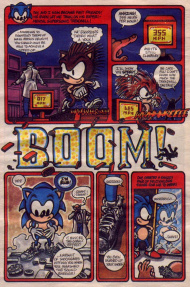
Not content with the simple explanation provided by Sega of Japan, Sega of America set to create their own origin of Sonic, meant to appeal to an American, and by extension, European audience. The first published version of this story, a comic written by Francis Mao, took a direction decidedly different from the Japanese explanation. In the comic, which takes the form of an extended flashback, Sonic explains to his animal friends how Robotnik, who appeared out of nowhere to terrorize the residents of the island, was actually once Dr. Ovi Kintobor. A benevolent scientist who only wished to save the world from the forces of evil, Sonic accidentally stumbled across the doctor's hidden laboratory while digging through the surface of the planet. The lanky, older doctor is stunned to find the small, brown, prickly hedgehog, but they soon become friends, Kintobor more than willing to share with Sonic what he has been working on in secret. He shows off his latest creation, his device to rid the world of evil: the Retro-Orbital Chaos Compressor (R.O.C.C. for short). Maintained by Containment Rings (which are meant to be the rings one collects in the games), the R.O.C.C. is powered by six Chaos Emeralds floating within, tasked to absorb all the evil energy on the planet Mobius. However, without the final seventh emerald, the R.O.C.C. remains in a state of flux.
In the interim, Kintobor decides to study Sonic's speed, putting him on an experimental treadmill meant to gauge how quickly he could run. In no time, Sonic reaches the speed of sound, causing the treadmill to explode and turning his hue from dirty brown to a brilliant blue. Kintobor says it must be the "cobalt effect," and makes him a pair of frictionless shoes to allow Sonic to keep on hitting these speeds without any further repercussions.
One fateful day, Kintobor asks Sonic to bring him a soda and a hardboiled egg, and due to the doctor's clumsiness, spills the soda onto the control panel of the R.O.C.C., infusing him with the total collected evil energy stored within. The transformation, aided by the hardboiled egg, causes Kintobor to take on the shape of the egg, completing the process to turn the gentle doctor into the villainous Dr. Ivo Robotnik. This version of the story was later rewritten by Mike Pattenden in the book Stay Sonic: Official Sega Handbook.
Sega’s official American homepage from 1996[3] expanded slightly on this story, showing that many of the attributes that made up Sonic were in fact learned from the animals that you rescue in the games. Johnny Lightfoot teaches Sonic how to run, Sally Acorn teaches him how to jump great distances, Joe Sushi shows him how to swim, Tux gives him the secret to breathing underwater, Flicky inspires his carefree approach to life, and Chirps shows him to do the Super Sonic Spin Attack. This pattern of having everyone else teach Sonic his moves even continued into the westernized Sonic the Hedgehog 2 manual, in which his new spin dash move was shown to him by Miles "Tails" Prower.
An early proposal of the westernized version of the Sonic story, in which some elements were used to make the above, can be read here.
Shogakukan Manga
One of the earliest transitions for Sonic from video game hero to alternate media, the Sonic the Hedgehog manga from the publication Shogaku Yonensei has Sonic as an alter-ego of another hedgehog named Nicky, who can transform into Sonic when need be. He is joined by Miles "Tails" Prower while in Sonic form, who assists in fighting the evil (if comical) villain Dr. Eggman. In his secret identity Nicky, he has an entirely different supporting cast, including early forms of Charmy Bee and Amy Rose. This version of Amy is actually Nicky's girlfriend, as opposed to the "self-proclaimed girlfriend" role she plays in the games. Even though she is with the bespectacled hedgehog, her heart still pines for Sonic, oblivious to the fact Nicky and Sonic are one and the same.
Sonic the Hedgehog (TV series)
The Saturday Morning cartoon Sonic the Hedgehog featured a vastly different origin than any previous continuity up to that point. While still portrayed as the "blue dude with an attitude," Sonic lives not on a planet that Dr. Robotnik wants to take over, but has already succeeded in doing so. Having overthrown the Acorn Kingdom and conquered Mobius ten years prior while Sonic was but five years of age, Sonic and a small group of friends are forced to grow up in a secluded area known as Knothole, located in the Great Forest and away from Robotnik's watchful eye. The majority of Mobium citizens have undergone a process known as Roboticization, created by Sonic's Uncle Chuck for benevolent purposes but misused by Doctor Robotnik.
Once Sonic and the rest of the Knothole Freedom Fighters reach their teenage years, they set about overthrowing the evil dictator, his nephew Snively, and his entire empire. Sonic is joined by Princess Sally Acorn (the love interest), Rotor Walrus (the go-to tech guy), Bunnie Rabbot (the sassy half-robotocized friend), Antoine D'Coolette (the comic relief), and Miles "Tails" Prower (the ever-loving sidekick) as they attempt to revert Robotropolis back to the city they once lived in, Mobotropolis, and rescue the exiled King Acorn from "The Void." Though Sonic often acts rashly when confronted with Dr. Robotnik's SWATBots, he will often defer to Princess Sally, who is the true leader of the Freedom Fighters and the resistance as a whole. Only on for two seasons, the final released episodes show the Freedom Fighters, along with Sonic, make a final push against his "Doomsday Project", with Sonic and Sally being the ones who end it. With Sonic able to admit his feelings for Sally, the series ended on a cliffhanger, canceled as the third season began per-production. To date, no official continuation of the series has ever been released.
Sonic the Hedgehog (Archie comics)
The Archie comic book series, Sonic The Hedgehog, takes the same basic premise of the Saturday Morning series, having Sonic and the rest fight off the evil Dr. Robotnik and attempt to free their home and their planet. However, Robotnik's grip is not as strong, as there are more pockets of resistance and less Roboticized Mobians within the story. Also, since the early issues used concepts from the series Adventures of Sonic the Hedgehog, the doctor was not originally portrayed as harshly as his televised counterpart, his schemes often having some sort of ridiculous premise behind them. It wasn't until the Sonic CD adaptation that the series slowly shifted gears, heading toward a version of Dr. Robotnik that resembled the Saturday morning version more and more with each passing issue, culminating in the now-infamous "Endgame" story arc.
In the aftermath of defeating Dr. Robotnik, Sonic and the rest of the Freedom Fighters set about transforming Robotropolis back into the city of their youth. In the process, Sonic discovers that his parents are still alive, having lived in the catacombs of Robotropolis, hidden there before the coup. His father, Jules Hedgehog, having been injured, was robotocized by Sir Charles Hedgehog in an attempt to save his life, unknowingly using machinery that had been tampered with by Robotnik (at the time calling himself Julian Kintobor of the House of Ivo). When completed, Sir Charles decides to renounce his status as Minister of Science in the Acorn Kingdom, overcome by the guilt of seeing his brother now nothing more than a mindless robot. Unknowingly, this action allowed Robotnik to claim not only the first victim of his coup d'etat, but his second - Sonic's mother, Bernadette Hedgehog. After the disappearance of his parents, Sonic ended up living with "Uncle Chuck" for a time, until Sonic was forced to escape to Knothole, his uncle becoming another casualty of the roboticization process. Though Sonic is at first upset at his uncle for keeping the fate of his parents a secret, he eventually forgives him and accepts his parents with open arms.
With the rebuilding of the Acorn Kingdom, Sonic and Tails go off on a mission to subdue Ixis Nagus, and make sure he does nothing to disturb the peace they have only recently acquired. Unfortunately, even though the duo are successful, the Freedom Fighters are brought together once more to go up against an alternate Dr. Robotnik (who eventually calls himself Dr. Eggman) from a parallel universe. Bored of his own conquered world, he travels to "Mobius Prime" to rule over the only version of Sonic the Hedgehog that was able to defeat him. Though the empire he acquires rises and falls many times throughout the run, Eggman remains the main antagonist and arch-rival to Sonic the Hedgehog.
Because of the serialized nature of the medium, and the tendencies of former main writer Ken Penders, Sonic's portrayal has ranged from the overtly silly to the dark and dreary. While Princess Sally Acorn is still presented as his main love interest, other characters such as Mina Mongoose and Fiona Fox have created love triangles and romance-orientated tales that are very different to the style and personality of the video game series.
The comic has also embraced the idea of Sonic being obsessed with chili dogs, a trait that runs through the DiC Entertainment produced animated series.
Sonic the Hedgehog (Troll Associates book)
Based on the Saturday morning series and the Archie comic book, as well as early concepts for both, the Troll Associates book Sonic the Hedgehog expands on Sonic’s origin in a slightly different way than the rest. While the elements of Knothole, Uncle Chuck, and the Freedom Fighters are all present, Dr. Robotnik is introduced not as a master villain or even a comical one, but as a teenager, only fifteen years of age. Having been orphaned, Uncle Chuck decides to take him under his wing, just as he does Sonic, who is seven at this point. Predictably, the two orphans refuse to get along, even though Uncle Chuck encourages both of them.
Things take a turn for the worse when Robotnik decides to raid Uncle Chuck’s tractor and use the steering parts for his latest robot. When Chuck hops on his tractor, it goes out of control, forcing Sonic to save both his uncle and Robotnik from being pinned to a tree. Uncle Chuck only finds out about Robotnik’s misdeed when one of his own robots snitches on the future doctor. Angry, Charles sends Robotnik to his room, where the future ruler of Mobius sets to make his largest robot yet, which Sonic has to save Uncle Chuck from.
Eight years later, Sonic is now working with Uncle Chuck at his chili dog stand, with brand new sneakers his uncle invented for him. After the largest order yet, Sonic runs off to discover that the order was a trap, and when he runs back home discovers that his uncle and dog Muttski have been kidnapped by the now ruler of Mobius, the evil Dr. Robotnik. Knowing he has to rescue his uncle, he stumbles across Princess Sally Acorn, who informs Sonic not only who she is, but what happened to her father. Together, along with the rest of the Freedom Fighters, they work to not only rescue Uncle Chuck, but restore the Kingdom of Acorn.
This origin story was also used in the original Archie mini-series, but presented as an imaginary story; a bad dream that Sonic is thankful never actually happened.
Adventures of Sonic the Hedgehog
Adventures of Sonic the Hedgehog (produced concurrently with Sonic's other animated series Sonic the Hedgehog) put Sonic once again on the planet Mobius, trying to stay slightly more faithful to the source material than its Saturday morning counterpart, making Sonic and Tails the main characters. Robotnik, while a dictator in his own mind, is never shown as actually having any part of Mobius truly under his thumb, or any real power whatsoever. Instead, he tries time and time again to defeat Sonic the Hedgehog, using absurd and wild plots that are slanted more towards the viewer's amusement than anything.
Sonic's portrayal is notable for his behaviour around Tails, taking an almost parental role towards him. Though he is often jerkish towards people that can slow him down, before learning to respect them later.
Sonic's attitude in the series is deeply rooted in the concept of what was "hip" in the early to mid-90's, spouting off slang and various catchphrases whenever possible. Possessing an appreciation of the opposite sex other versions of the character have overlooked,to the point he acts absurd around females he finds attractive. Sonic also had a tendency to disguise himself to trick Robotnik and his minions Scratch and Grounder, allowing their plans to blow up in their faces as a result. Even though episodes such as the Chaos Emerald saga tried to raise the stakes, the characters in the series made sure to not take any event too seriously.
Sonic the Comic
The UK-based Sonic the Comic, produced by Fleetway, took the origin story that Sega of America had produced as a basis, later introducing concepts and ideas from the other Sonic media of the time. While at first a very basic comic book, issue #8 retold the Kintobor origin, at the same time having Robotnik sending Sonic a few months into the future. Instead of having Sonic prevent Robotnik from taking over the world, he now had to liberate Mobius with the help of staples like Miles "Tails" Prower and Amy Rose, as well as alternate versions of his animal friends from the games, Johnny Lightfoot and Porker Lewis.
Sonic is very agressive and defensive, Nigel Kitching has explained that he acts this way on purpose to look tough.
While many other original elements were presented, the comic tried to keep as strong ties to the original games as possible, using enemies and zones from the games in the storyline. Sonic, meanwhile, possessed a slightly harder edge to his personality than in the DiC-produced animated series, being slightly more obsessed with himself and even being vocally aggressive to his friends.
At one point, it is revealed that Robotnik was not the one who originally designed Metal Sonic (called Metallix in the comic book), but that it was instead created by his assistant Grimer, and that Robotnik only installed a self-destruct mechanism in the off-chance they would rebel against him. When discovered, the Metallix go back in time to prevent the creation of Dr. Robotnik so this fail-safe device would not be implanted within them, forcing Sonic to go back in time and insure that Dr. Kintobor would indeed transform into the evil doctor. Because of this, Sonic realized that he was the one responsible for the creation of his greatest enemy, and the events that had transpired so far in the series.
Another aspect of the Fleetway series that was unique to its continuity was the presentation of Super Sonic. While still a super-powered form of Sonic the Hedgehog, Super Sonic was a force of nature that was wild and uncontrollable, often being more destructive than Dr. Robotnik. While there were times when Super Sonic had to be called into action, it was only as a last resort, for while he would defeat whatever it was the Freedom Fighters could not, he would immediately turn his attention to his friends and try to wipe them out. In the end, all anyone could do was wait it out, hoping that the Chaos energy would dissipate, turning Sonic back to normal before too much trouble was to be had.
Sonic the Hedgehog (Anime)
Produced under the supervision of Sonic Team, this two-part Japanese anime brought to life another version of Sonic the Hedgehog, also based on the games but once again being significantly different. Given no clear backstory, it is established that Sonic lives somewhere on South Island in the ruins of an airliner, and prefers to relax in this tropical locale than being needlessly bothered by other people. Sonic's personality leans more toward his Fleetway counterpart than his Adventures of Sonic the Hedgehog one. Sonic's portrayal displays more in the way of hot-temper and is unpredicatable. He can snap at his friends and initially seem uncaring but he does express sympathy for Tails' fear of lightening and for Hyper Metal Sonic's fate. One moment Sonic may seem lazy and the next energetic and ready for adventure, while he will still rush in to save his friends from certain danger and Dr. Eggman. There are occasionally times when he wishes to be left alone.
While Sonic and Eggman end up face to face often through the course of the show, the hedgehog never shows any sign of being intimidated or frightened of Eggman or his plans. Instead, he chooses to make snide remarks, teasing him and his forces. The only villain in the piece he shows anything more to is Metal Sonic, and only once he recognizes that elements of his own personality were used to create the machine. It is also hinted at that he and Sara (the damsel-in-distress of the show) have some sort of attraction to each other, though neither explores it beyond simple flirting, mostly on Sara's part.
Sonic Underground
Once again creating a completely different origin story, DiC Entertainment chose to produce an animated series having nothing to do with either of their previous efforts. Born into a royal family, Sonic and his two siblings, Manic and Sonia the Hedgehog, are separated from their mother because of the intervention of Dr. Robotnik, who overthrows the kingdom. Maintaining his rule by appealing to the upper class, Dr. Robotnik's role as dictator forces the three hedgehog siblings to be raised by other families, and are only reunited once they reach their teenage years. Sonic, Sonia, and Manic then decide to form an underground rock group, appropriately named Sonic Underground. They use the band as a front to gather intelligence and to one day reunite with their mother, Queen Aleena, and overthrow Dr. Robotnik once and for all.
Sonic X
Sonic is quiet, solitary and stoic, his characterisation is mainly that of an idol for Chris to look up to.
The second animated project under the direct supervision of Sonic Team, Sonic X is closely based on the Sonic Adventure-era of Sonic's history, even sharing the same voice actors in the Japanese original. However, instead of living on a planet where humans and animals coexist, Sonic and his friends come from a separate reality on an unnamed planet. It is only because of Dr. Eggman's latest invention that causes a warp in space and time utilizing Chaos Control that sends the cast to the planet Earth, where Sonic immediately gets into trouble. After running from the police, he finds himself trapped in a pool, unable to escape until he gets help from a child who lives there, Chris Thorndyke. The two immediately become friends, and it isn't long before Miles "Tails" Prower, Amy Rose and Cream the Rabbit also become friends with the Thorndyke clan, making up residence there until they can find a way back home.
While the first 26 episodes are unique stories, the second half of series one decided to adapt Sonic Adventure, Sonic Adventure 2 and Sonic Battle, making changes to their individual stories as necessary. It was during this era of the show that Chris Thorndyke was replacing certain roles that were already taken up by other characters, including the role of sidekick and the person-in-distress. For example in the adaptation of Sonic Adventure 2, where he takes Amy's role in the story, being the one to convince Shadow the Hedgehog to join with the other heroes to prevent the Space Colony ARK from crashing into Earth. So while the series is one of the closest attempts to bring the games into alternate media, there are still some differences which make Sonic X its own unique world.
Miscellaneous
| |
Trivia sections are bad Try and incorporate this information into the main article. See the manual of style to find out why. |
|---|
- While Sonic's first staring role was in his self-titled 16-bit adventure, he first appeared in a cameo in the game Rad Mobile as the rearview mirror ornament. This was also the first of many cameos Sonic would have in other games, perhaps the most famous being the mountain carving found in the first track of Daytona USA.
- When it became possible to trademark certain three dimensional shape configurations for trademarked products and objects, Sonic the Hedgehog was one of the very first fictional characters to have his all-round shape trademarked.
- Interestingly, one of a class of genes involved in fruit fly embryonic development, called hedgehog genes after the name given to the first member of this class discovered, has been named sonic hedgehog after this character. The same gene (named shh for simplicity) has been found to be, in conjunction with other genes, pivotal in the formation of the pentadactyl limb in mice, and plays an interesting role in shaping the brain.
- Sonic the Hedgehog was the first video game character to be immortalized in balloon form at the Macy's Thanksgiving Day Parade. The first year it was on the route (1993), it also crashed into a streetlight, but no major injuries occurred from the collision.[4]
- Sonic's age has always been a tricky one to pinpoint. According to the Sonic Technical Files, it says he is 18, "but it's kinda hard to tell." In a video for those who preordered Sonic the Hedgehog 3 in Japan, Sonic's age was listed as being "15~16."[5] This continued with the Japanese version of Sonic Jam. However, the English version of Sonic Jam changed this to just be "16". With the Sonic Adventure era, his age is now listed as 15. Making things just a bit more confusing is the fact that Sonic Generations begins with Sonic being greeted to a surprise "birthday party," which occurs across every region and platform the game was released in.
Appearances
Video Games
See Games featuring Sonic the Hedgehog.
Television Series and Film
- Adventures of Sonic the Hedgehog (AoStH, US)
- Sonic the Hedgehog (SatAM, US)
- Sonic Underground (US, France)
- Sonic the Hedgehog (Anime, Japan)
- Sonic X (Anime, Japan)
Comic Books
- Sonic the Hedgehog Story Comic (Softbank Publishing, Japan)
- Sonic the Hedgehog (Shogakukan, Japan)
- Sonic the Hedgehog (Archie Comics, US)
- Sonic the Comic (Fleetway, UK)
- Sonic Adventures (La Sirène Sources, France)
- Sonic X (Archie Comics, US)
- Dash & Spin (Shogakukan, Japan)
Sonic fan-made dōjinshi have also been released in Japan.
Game Books and Novels
Please see Books Featuring Sonic the Hedgehog.
Theme Songs
- It Doesn't Matter (SA1)
- It Doesn't Matter (SA2)
- We Can
- His World
- High Flying Groove
- Un-gravitify
- Endless Possibility
- Knight of the Wind
- Reach For The Stars
- Free
Voice Actors
- Keiko Utoku (Sonic the Hedgehog CD)
- Takeshi Kusao (SegaSonic the Hedgehog)
- Jaleel White (Adventures of Sonic the Hedgehog, Sonic the Hedgehog, Sonic Underground - English)
- Samuel Vincent (Sonic Underground, Singing voice - English)
- Masami Kikuchi (Sonic the Hedgehog (anime) - Japanese)
- Martin Burke (Sonic the Hedgehog (anime) - English)
- Junichi Kanemaru (Japanese game voice (1998-present) plus Sonic X)
- Ryan Drummond (English game voice (1999-2004))
- Jason Griffith (English game voice (2005-2010) plus Sonic X)
- Tomokazu Seki (Sonic Unleashed, Werehog only - Japanese)
- Roger Craig Smith (English game voice (2010-present))
Gallery
References
